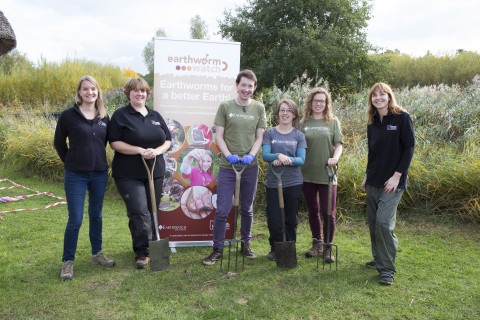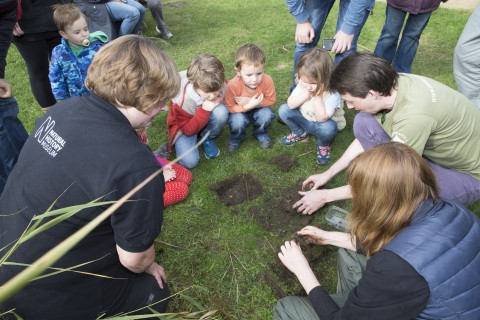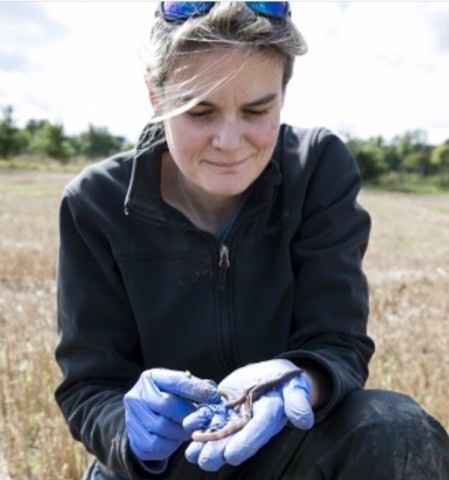After the recent release of David Attenborough’s Life That Glows which featured the bioluminescent earthworm found in the Loire Valley, France, you may well ask whether any of the 31 earthworm species found in the UK and Ireland have this seemingly preternatural ability. Well yes! Indeed there is a species in the UK that emits a greenish glow when disturbed.
You’ll need a keen eye to find Microscolex phosphoreus, it is pale and threadlike being only 1.0-1.5mm in width and measuring only 10-35mm in length. Its bioluminescence is easily overlooked and is only discernible at night. You are more likely to notice their casts, these are sandy and small being 10-20mm in diameter and stand up to 15mm in height. Microscolex phosphoreus seems to occur in isolated populations, in the localities more densely populated by these earthworms some 340 casts per m2 have been recorded (Jones, D.T. 2011).
Ever wondered why an earthworm that spends the majority of its existence beneath the surface of the soil needs to produce bioluminescence? The hypothesis is that earthworm bioluminescence is produced as a defence mechanism. The bright light could make the earthworms appear unpalatable to predators. It could also startle negatively phototactic predators, in other words predators which usually avoid bright light preferring to hunt in the dark either under cover of night or underground, giving the earthworm time to wriggle away (Gilchrist.1919. Trans. Roy. Soc. South Africa 7: 203-12; Jamieson and Wampler. 1979. Australian J. Zool. 27: 637-69).
With similar outcomes to the earthworm vs. predator confrontation in Attenborough’s Life that Glows, in an experiment to test this hypothesis Microscolex phosporeus was observed producing bioluminescence in reaction to attacks by an Earwig Labidura riparia (Pallas 1773), an immature Wolf spider of the family Lycosidae and a Mole cricket Neoscapteriscus borelli (Sivinski and Forrest). You can read a blow-by-blow account of the outcomes here.
Microscolex phosphoreus is native to temperate regions of South America and it is probable that it was introduced to the UK through historic translocation of plants or the off-loading of rocks and soil used as ship ballast. It was first recorded in Jersey and Worcestershire in 1899 (Beddard 1899:52; Friend 1931:459) and in market gardens in Nottinghamshire in 1913 (Friend 1913a:24).
Unsurprisingly Microscolex phosphoreus has predominantly been recorded by greenkeepers who routinely scrutinise their grounds and the condition of the sward. In recent years there have been at least 20 confirmed records and a number of unconfirmed sightings ranging from Kent and Cornwall across the country to North Yorkshire (Jones and Entwistle 2010) and in Devon in 2014.
Remember, look out for a number of tiny, sandy or dusty piles…happy hunting!
Jones, D.T. 2011, Return of the Worm: Earthworms in the Post-chlordane Era. The British and International Golf Greenkeepers Association Limited [Online] Monday, 8th August 2011 Available at: http://www.bigga.org.uk/about-us/news/return-of-thhlordane-era/00274.html [Accessed: 6 June 2016]
Jones, D. T., Entwistle, K. 2010. Close-mown Greens Face a New Menace. Greenkeeper International [Online] April 2010, pp41 Available at: http://archive.lib.msu.edu/tic/bigga/gki/article/2010apr.pdf [Accessed: 6 June 2016]
Sivinski, J., Forrest, T. Luminous Defense in an Earthworm Florida Entomologist, Scientific Notes, Florida Agricultural Experiment Station Journal Series No. 4545 [Online] pp571 Available at: http://journals.fcla.edu/flaent/article/viewFile/57860/55539 [Accessed: 6 June 2016]




